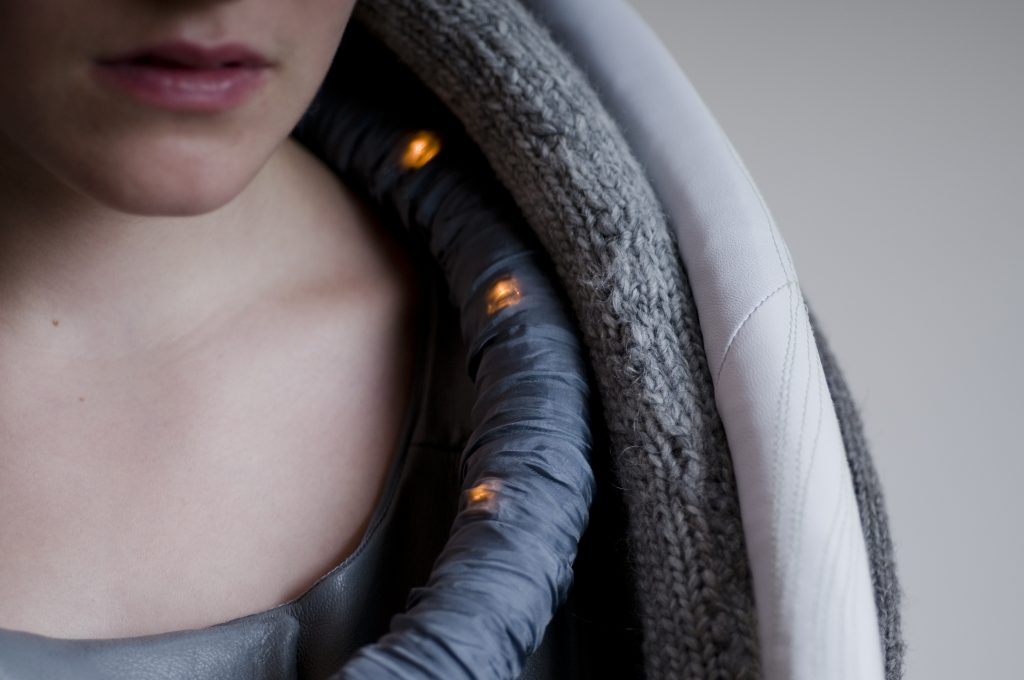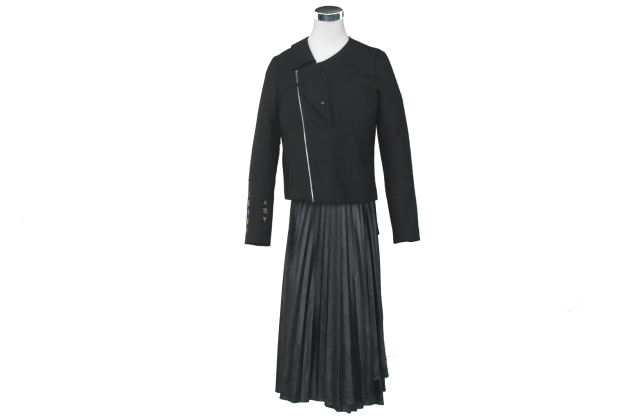
When fashion met technology
Features 360Fashion Network Concordia University editor pick editors pick Electric Runway fashion technology OMsignal Ralph Lauren Sensoree Smart fashion XS Labs
 PHOTO: Guillaume Pelletier
PHOTO: Guillaume Pelletier Integrating tech into everyday clothes in order to make for a more seamless and intuitive way to interface with the digital world has been an idea long in the making.
Today, smart clothing is a category in itself, ranging across a wide variety of applications, involving both form and function.
“It’s such a huge space — it almost defies categorization,” Joanna Berzowska, founder of XS Labs and associate dean research of the Faculty of Fine Arts at Concordia University, said in a recent interview with Smart Homes. “But one way we can try and understand that is to look at contexts.”
The main areas of smart fashion tech that have seen some innovation in recent years are in sports and performance (see sidebar) and high fashion or art projects for the runway.
Berzowska — who helped develop the PoloTech shirt for Ralph Lauren as the head of Electronic Textiles at OMsignal — notes that while the smart fashion industry has been gaining traction, she says that there has always been “interesting tension” within the field of fashion technology.
“It’s really combining these two industries: the fashion industry and the consumer electronics industry,” Berzowska explains. “They both historically work on very tight margins and very specialized manufacturing environments, and by trying to put them together.”
Amanda Cosco, a Toronto-based fashion tech expert and founder of the Electric runway, an ongoing multimedia project documenting how technology is transforming the fashion industry, says that one of the hurdles that the smart fashion industry has faced is this notion that consumers are not used to their clothes being made of hardware.
“A lot of the early examples of smart fashion involve trying to upload our bodies into the Internet of Things (IoT) by taking all this biometric data, and by quantifying the body and getting it into the ones and zeros that is the internet, and I would say that over the last 10 years we’re still on that mission,” Cosco relates. “There’s a lot happening right now on the digital fashion side, and it seems that the people who were experimenting with making smart fashion and smart textiles have now moved towards making environments in which these products can actually thrive.”
When clothes speak
Cool aesthetics aside, electronic garments increasingly been used to help consumers tell a story without opening their mouth.
An example that sticks out in Cosco’s mind is San Francisco-based Sensoree’s Galvanic Extimacy Responder (GER) mood sweater, a soft sensor based on the Galvanic Skin Response (GSR), which reads electrodermal activity.
“It uses the same technology that a lie detector would use to read the emotion from the palm of your hand and then it’s connected to this cowl on the sweater, and the sweater lights up depending on your emotions,” Cosco explains. “We already know on an intuitive level when we’re feeling great and we’re ready for the world, we will wear bright colours. Or if we’re feeling moody, we’ll wear something dark but the GER sweater has the data to prove how you’re feeling.”
While some may think that the sweater’s unique and “funny” design and function may not be popular amongst consumers, Cosco shares that the GER sweater has been able to help people who are struggling to communicate and need some extra help.
“In couples therapy and in treating children with autism, [the sweater] has been really useful in understanding emotion, especially for people who are having a hard time communicating emotion,” Cosco says.
Anina Net began her career first as a model and then evolved to a fashion technology industry pioneer when she founded the 360Fashion Network, a network of fashion professionals bringing the latest technologies to the fashion industry.
Net’s portfolio of fashion technology innovations includes the development of a smart glove that is powered by Intel’s Curie with the LED light pattern generated using gesture recognition, robotic dresses, as well as tech maker kits.
“These kits are there for fashion designers to take the ‘hard’ out of hardware, and make it easier for them to develop and experiment with this and one of the kits is a smart heating coat kit,” Net shares. “The kit comes with everything that designers need to focus on is the integration and design thinking. Right. I’ve already been working on heated coats.”

The IoT Jacket by Anina Net PHOTO: 360 Fashion Network
Net’s most recent smart innovation is a smart IoT Jacket and luxury designer DrinkBot robot for boutique hotels with a small staff.
The project was conceived of under the theory that hotel staff suffer from high turnover due to the high-stress environment of hospitality.
The IoT Jacket comes with five embroidered textile buttons on the right sleeve and three on the inner wrist. These buttons can be programmed to interface with the smart hotel cloud system and dynamically change the lighting, the music and the temperature with a swipe across a respective button.
“I often construct smart garments using the pillow effect that we have the outer layer and we have the inner guts layer and then we have the layer which attaches to the skin,” Net explains. “We worked really hard to make it as if the feel and the fit that you don’t even sense that you’re wearing anything with technology in it.”
Room to grow
As trends come and go in fashion, the smart fashion space will continue to have more room to grow as more technological innovations become available.
Looking ahead, Net says that smart fashion will continue to find ways to bring the digital world into the physical world.
“I think that screen-based clothing will be extremely popular, to the Bitcoin mining crowd,” Net says. “I think the other trend will be smart mirrors, because clothing will transmit sensor-wise the information to the smart home and then the smart home will read display edge to the mirrors so when we look in the mirror, we will have this data reflected back at us.”
Referring to her “wish list” of fashion technology trends for the future, Berzowska would love to see textiles that have the ability to comfort, hug and massage someone, mimicking human touch.
“I would love to see technology like that, especially during like this time of isolation where we’re all missing human contact and we’re missing visceral experiences and immersive experiences,” Berzowska says.
In terms of other trends, Berzowska sees the idea of colour changing clothes or light up clothing are interesting in an art or entertainment context, but she does not believe that it will ever become part of mainstream fashion.
“Increasingly, we’re seeing art projects and costumes — whether it’s high fashion costumes or costumes for award shows — is either electronic, blinking or it moves,” Berzowska observes. “It’s really good that designers are experimenting and doing these performances for the runway — it helps tell the narrative of the brand and communicate values of each brand, where I definitely do see a huge trend.”
Getting smart about fitness
Smart technology sparked a fitness revolution, with consumers itching for the latest AppleWatch and FitBit.

Joanna Berzowska
Joanna Berzowska, founder of XS Labs and associate dean research of the Faculty of Fine Arts at Concordia
University, says that smart fashion has also found a prominent space in the fitness space.
“If we look at the context of like sports and performance, a lot of them really focus on biometric monitoring in order to help you increase or improve your performance and be the best that you can be,” Berzowska relates.
Berzowska was integral to the creation and launch of fashion label Ralph Lauren’s PoloTech shirt, a tee that has the ability to deliver live metrics from the shirt to your iPhone.
“[The PoloTech] was very much about tracking through these embedded electronic sensors,” Berzowska explains, “It was tracking your full electrocardiogram (ECG), and then from that looking at heart rate variability, which allows you to track really detailed aspects of your cardiovascular performance tracking breathing.”
While wearables have been a popular option in smart fitness for a number of years, Berzowska explains that with products like the FitBit or AppleWatch, they are easy for consumers to discard or forget to use on a daily basis. Smart fashion for sports appeals to consumers because of the frequency of use.
“That’s why the idea of a biometric shirt seems so attractive because everybody wears shirts – most of the time, anyway,” Berzowska concludes with a laugh.